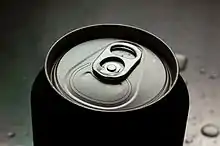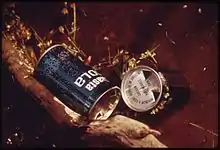Aluminum can
An aluminum can (British English: aluminium can), sometimes erroneously referred to as a "tin can", is a single-use container for packaging made primarily of aluminum.[1] It is commonly used for foods and drinks such as beer, baked beans and soup but also for products such as oil, chemicals, and other liquids. Global production is 180 billion annually[2] and constitutes the largest single use of aluminum globally.[3]
.JPG.webp)
_02.JPG.webp)

Usage
Use of aluminum in cans began in 1957.[4] Aluminum offers greater malleability, resulting in ease of manufacture; this gave rise to the two-piece can, where all but the top of the can is simply stamped out of a single piece of aluminum, rather than constructed from two pieces of steel. The inside of the can is lined by spray coating an epoxy lacquer or polymer to protect the aluminum from being corroded by acidic contents such as carbonated beverages and imparting a metallic taste to the beverage.[5] The epoxy may contain bisphenol A.[6] A label is either printed directly on the side of the can or will be glued to the outside of the curved surface, indicating its contents.
Most aluminum cans are made of two pieces. The bottom and body are "drawn" or "drawn and ironed" from a flat plate or shallow cup. After filling, the can "end" is sealed onto the top of the can. This is supplemented by a sealing compound to ensure that the top is air tight.
The advantages of aluminum over steel (tinplate) cans include;
- light weight
- competitive cost
- usage of easy-open aluminum ends: no need for a can opener
- clean appearance
- aluminum does not rust
- easy to press into shape
The easy-open aluminum end for beverage cans was developed by Alcoa in 1962 for the Pittsburgh Brewing Company[7] and is now used in nearly all of the canned beer market.[8]
Recycling

Aluminum cans can be made with recycled aluminum. In 2017, 3.8 million tons of aluminum, were generated in the US of which 0.62 million tons were recycled - a recycling rate of 16%.[9] According to estimates from the Aluminum Association, a large amount of aluminium remains unrecycled in the US, where roughly $700 million worth of cans end up in landfills.[10] In 2012, 92% of the aluminum beverage cans sold in Switzerland were recycled.[11] Cans are the most recycled beverage container, at a rate of 69% worldwide.[12]
According to Alcoa Aluminum Company, in 2015 about 34 cans are required to achieve a weight of one pound. The unstated assumption is that most of those will be the typical 12-ounce can. Wise Recycling in Pensacola, FL also reported that the price they paid for aluminum cans varied, based on the published price of aluminum in the commodities market. They denied that there was a seasonal price fluctuation, and stated that the nationally published commodity price was the sole determining factor in what they paid.
One issue is that the top of the can is made from a blend of aluminum and magnesium to increase its strength. When the can is melted for recycling, the mixture is unsuitable for either the top or the bottom/side. Instead of mixing recycled metal with more aluminum (to soften it) or magnesium (to harden it), a new approach uses annealing to produce an alloy that works for both.[13]
The aluminum can is also considered the most valuable recyclable material in an average recycling bin. It is estimated that Americans throw away nearly 1 billion dollars a year in wasted aluminum. The aluminum industry pays nearly 800 million dollars a year for recycled aluminum since it is so versatile.[14]
Because of the advantages of aluminium packaging (shelf life, durability, food grade factor) over plastics, it is considered an alternative to PET bottles, with the possibility of replacing the majority of them in the next decades.[15][10]
References
- Soroka, W. Illustrated Glossary of Packaging Terminology (Second ed.). Institute of Packaging Professionals.
- Waldman, Jonathan. "The Secret Life of the Aluminum Can, a Feat of Engineering". Wired. Retrieved 9 March 2015.
- Byrne, Brendan (27 May 2016). "The Rise of the Beer Can". The Atlantic. Retrieved 28 May 2016.
- Petroleum week, Volume 9, 1959, p. 82 (Google Books)
- Dockrill, Peter (May 22, 2019). "Viral Video Reveals The Bizarre Way You Can Make a Soda Can Fully Transparent". Science Alert. Retrieved 17 July 2019.
- Bell-Young, Lucy (March 28, 2018). "The Science Behind a Soda Can". ReAgent. Retrieved 17 July 2019.
- "Archived copy". Archived from the original on 2013-08-28. Retrieved 2013-07-10.CS1 maint: archived copy as title (link)
- Steeman, Anton. "Beverage Can Ends and its Opening Devices". Best In Packaging. Archived from the original on 2016-03-25. Retrieved 2016-07-28.
- "1960-2017 Data on Aluminum Metals in MSW by Weight (in thousands of U.S. tons)". EPA. Retrieved 26 January 2020.
- Calma, Justine. "ALUMINUM IS RECYCLING'S NEW BEST FRIEND, BUT IT'S COMPLICATED". The Verge. Retrieved 17 September 2019.
- "BAFU - Publikationen, Medien - Anzeige NSB unter Medienmitteilungen". Bafu.admin.ch. 2008-08-19. Retrieved 2016-07-28.
- "Sustainability Reports | The Aluminum Association" (PDF). Aluminum.org. Retrieved 2016-07-28.
- Wald, Matthew L. "Toward a Greener Soda Can - NYTimes.com". Green.blogs.nytimes.com. Retrieved 2012-06-13.
- "Recycling | The Aluminum Association". www.aluminum.org. Retrieved 2016-09-18.
- "Will Aluminium Cans Replace Plastic Bottles?". Forbes. 2 September 2019. Retrieved 17 September 2019.